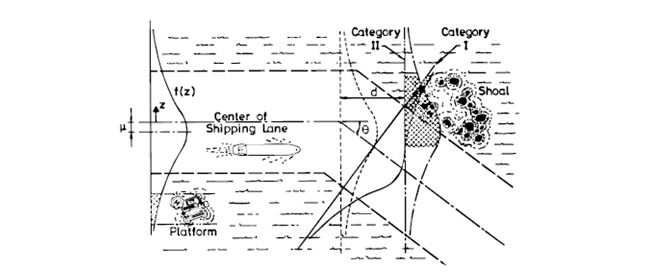Interpretation of causation factors in IWRAP
By Markus Porthin, VTT, 18 February, 2010
The main idea on estimating grounding and collision frequencies in IWRAP (extracted from [1])
Today most risk models for estimating the grounding or collision frequency are rooted in the approach defined by Fujii et al. and by MacDuff. That is, the potential number of ship grounding or ship-ship collisions is first determined as if no aversive manoeuvres are made. This potential number of ship accidents is based on:
- an assumed or prespecified geometric distribution of the ship traffic over the waterway and
- on the assumption that the vessels are navigating blindly as these are operating at the considered waterway.
The thus obtained number of potential accident candidates (often called the geometric number of collision candidates) is then multiplied by a specified causation probability to find the actual number of accidents.
The causation probability, which acts as a thinning probability on the accident candidates, is estimated conditional on the defined blind navigation.
Interpretations of causation factors - Collision scenarios.
| Incident type | Scenarios and Interpretation of causation factor (PC) | |
|---|---|---|
| Head-on collision | Scenarios:
The theory on head-ons is solid and well documented. However, it should be noted that due to the modelling assumptions it is possible e.g. for a single ship to collide with itself. | |
| Overtaking collision | Scenarios:
The theory on overtakings is solid and well documented. | |
| Crossing collision | Scenarios:
We use the information of “from-leg – to-leg” for the two vessels to calculate the crossing angle between the two ships | |
| Merging collision | Scenarios:
We use the information of “from-leg – to-leg” for the two vessels to calculate the crossing angle between the two ships (same as crossing collisions) | |
| Bend collision | Scenarios:
The probability of omitting to change course at the intersection is taken as 0.01, see footnote(2). The exact calculation of this scenario is documented somewhat ambiguously in [1] (equation missing). The bend collision model does not account for the lateral distance between the traffic in opposite directions. This leads to too high collision estimates e.g. in TSSs. The possibility of collisions in a bend between two ships sailing in same direction is neither accounted for in the model. Note from PFH (20100311): It is stated in ref. 1 that bend collisions are treated as crossing collisions, but is using a different causation factor. With respect to the comment on the analysis not accounting for the distance between the two lanes, it is noted that the applied causation factor account for the navigator failing to make a turn. The distance between the two lanes may have an influence on the occurrence on a collision, provided that the navigator realises that he has failed to turn and managed to react in time to avoid the collision. To model the situation we would need a checking-time (as used in the powered grounding analysis) – we find this modelling too detailed for a bend analysis. The user is recommended to adjust the causation factor for bend such that it accounts for the increased awareness in the traffic separation scheme. |
Interpretations of causation factors - Powered grounding scenarios.
Ref. [1] specifies four grounding categories, two of which are illustrated here:
Grounding categories I and II are referred to as "groundings" in IWRAP. The same grounding causation factor in IWRAP is applied to powered groundings of both category I and II.
| Incident type | Scenarios and Interpretation of causation factor (PC) | |
|---|---|---|
| Category I grounding | Scenarios:
IWRAP Mk2 uses the same Pc for both Category I and II | |
| Category II grounding | Scenarios:
The ships that notice the omitted turn before running aground are all assumed to be able to avoid the grounding. Another important parameter is the Mean time between checks. |
Footnotes
- To be precise, only the omission of changing course of the ship in the inner curve is critical. If the ship in the outer curve forgets to turn, the two ships do not end up on collision course.
- See [1], page 28.
References
[1] Peter Friis-Hansen: IWRAP MK II. Basic Modelling Principles for Prediction of Collision and Grounding Frequencies. Working document, Technical University of Denmark, Date: 2007.08.01, Rev. 4: 2008.03.09
[2] IWRAP Wiki site, IALA. ( this site) http://www.ialathree.org/iwrap
